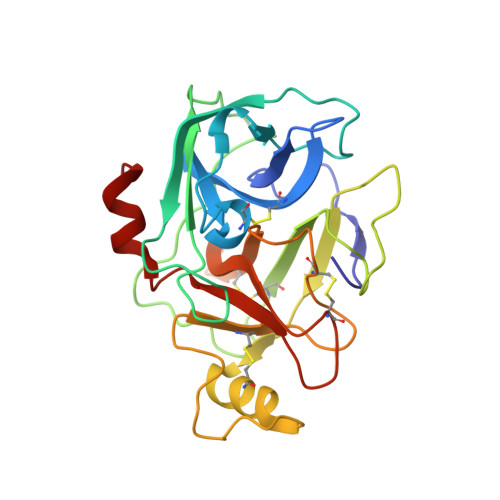A Novel, Nonpeptidic, Orally Active Bivalent Inhibitor of Human beta-Tryptase.
Giardina, S.F., Werner, D.S., Pingle, M., Bergstrom, D.E., Arnold, L.D., Barany, F.(2018) Pharmacology 102: 233-243
- PubMed: 30134249
- DOI: https://doi.org/10.1159/000492078
- Primary Citation of Related Structures:
4MPW - PubMed Abstract:
β-Tryptase is released from mast cells upon degranulation in response to allergic and inflammatory stimuli. Human tryptase is a homotetrameric serine protease with 4 identical active sites directed toward a central pore. These active sites present an optimized scenario for the rational design of bivalent inhibitors, which bridge 2 adjacent active sites. Using (3-[1-acylpiperidin-4-yl]phenyl)methanamine as the pharmacophoric core and a disiloxane linker to span 2 active sites we have successfully produced a novel bivalent tryptase inhibitor, compound 1a, with a comparable profile to previously described inhibitors. Pharmacological properties of compound 1a were studied in a range of in vitro enzymic and cellular screening assays, and in vivo xenograft models. This non-peptide inhibitor of tryptase demonstrated superior activity (IC50 at 100 pmol/L tryptase = 1.82 nmol/L) compared to monomeric modes of inhibition. X-ray crystallography validated the dimeric mechanism of inhibition, and 1a demonstrated good oral bioavailability and efficacy in HMC-1 xenograft models. Furthermore, compound 1a demonstrated extremely slow off rates and high selectivity against-related proteases. This highly potent, orally bioavailable and selective inhibitor of human tryptase will be an invaluable tool in future studies to explore the therapeutic potential of attenuating the activity of this elusive target.
Organizational Affiliation:
Department of Microbiology and Immunology, Joan and Sanford I. Weill Medical College of Cornell University, New York, New York, USA, [email protected].


















